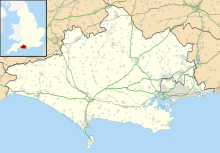User:Harrias/Siege of Sherborne (1642)
| Siege of Sherborne | |||||
|---|---|---|---|---|---|
| Part of the First English Civil War | |||||
 The ruins of the castle, pictured in 2010 | |||||
| |||||
| Belligerents | |||||
| Royalists | Parliamentarians | ||||
| Commanders and leaders | |||||
| Marquess of Hertford | Earl of Bedford | ||||
Location within Dorset | |||||
The Siege of Sherborne (2–20 September 1642) was a pair of attacks by the Parliamentarians on Royalist-held Sherborne, Dorset, in South West England, during the early stages of the First English Civil War.
Background[edit]
Religious, fiscal and legislative tensions between Parliament and King Charles had existed throughout his reign,[1] and in 1642 they escalated sharply after Charles had attempted to arrest five members of parliament. The King appointed the Marquess of Hertford as commander of his forces in the West Country, supported by Sir Ralph Hopton, a local member of parliament (MP) and an experienced army officer. The county of Somerset was generally more sympathetic towards Parliament than towards the King,[2] and after the Royalists established quarters at Wells they were constantly under threat. They won a minor skirmish at Marshall's Elm, where their superior cavalry and leadership helped them defeat a much larger Parliamentarian force,[3] but they were forced to leave the town on 6 August when the local population rose against them, wielding "pitchforks, dungpecks, and suchlike weapons."[4] Hertford retreated to Sherborne in Dorset, where he garrisoned the castle.[5] Dorset was split in its sympathies: most of the larger towns favoured parliament; but in more rural areas, and to the north of the county generally, the Royalists had more support.[6]
Prelude[edit]
First siege[edit]
Second siege[edit]
Aftermath[edit]
Notes[edit]
References[edit]
- ^ Bleiberg & Soergel 2005, pp. 344–348.
- ^ Barratt 2004, p. 78.
- ^ Underdown 1973, p. 36.
- ^ Brooks 2005, pp. 382–383.
- ^ Edgar 1968, pp. 24–25.
- ^ Goodwin 1996, p. 31.
Bibliography[edit]
- Barratt, John (2004). Cavalier Generals: King Charles I and His Commanders in the English Civil War 1642–46. Barnsley: Pen & Sword Military. ISBN 1-84415-128-X.
- Batten, John. Jr. (1854). "Somersetshire Sequestrations during the Civil War". Proceedings of the Somersetshire Archaeological and Natural, Volume 4. Taunton: Frederick May. OCLC 852129971.
- Bayley, A.R. (1910). The Great Civil War in Dorset 1642–1660. Taunton: Barnicott and Pearce. OCLC 6937209.
- Bleiberg, Edward; Soergel, Philip, eds. (2005). "The English Civil Wars". Arts and Humanities Through the Eras. Vol. 5: The Age of the Baroque and Enlightenment 1600–1800. Detroit: Gale. ISBN 978-0-787-65697-3.
- Brooks, Richard (2005). Cassell's Battlefields of Britain and Ireland. London: Weidenfeld & Nicolson. ISBN 0-304-36333-2.
- Edgar, F. T. R. (1968). Sir Ralph Hopton. The King's Man in the West (1642–1652). Oxford: Clarendon Press. ISBN 0-19-821372-7.
- Goodwin, Tim (1996). Dorset in the Civil War 1625–1665. Tiverton: Dorset Books. ISBN 1-871164-26-5.
- Hopton, Ralph (1902). Chadwyck-Healey, Charles (ed.). Bellum civile. London: Printed for subscribers by Harrison and Sons. OCLC 1041068269.
- Manganiello, Stephen C. (2004). The Concise Encyclopedia of the Revolutions and Wars of England, Scotland, and Ireland, 1639–1660. Lanham, Maryland: The Scarecrow Press. ISBN 0-8108-5100-8.
- Morris, Robert (2000). The Battle of Babylon Hill Yeovil 1642. Bristol: Stuart Press. ISBN 1-85804-156-2.
- Underdown, David (1973). Somerset in the Civil War and Interregnum. Newton Abbot: David & Charles. ISBN 0-7153-5805-7.

